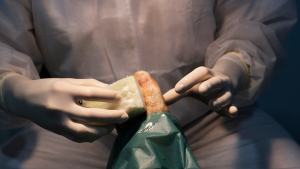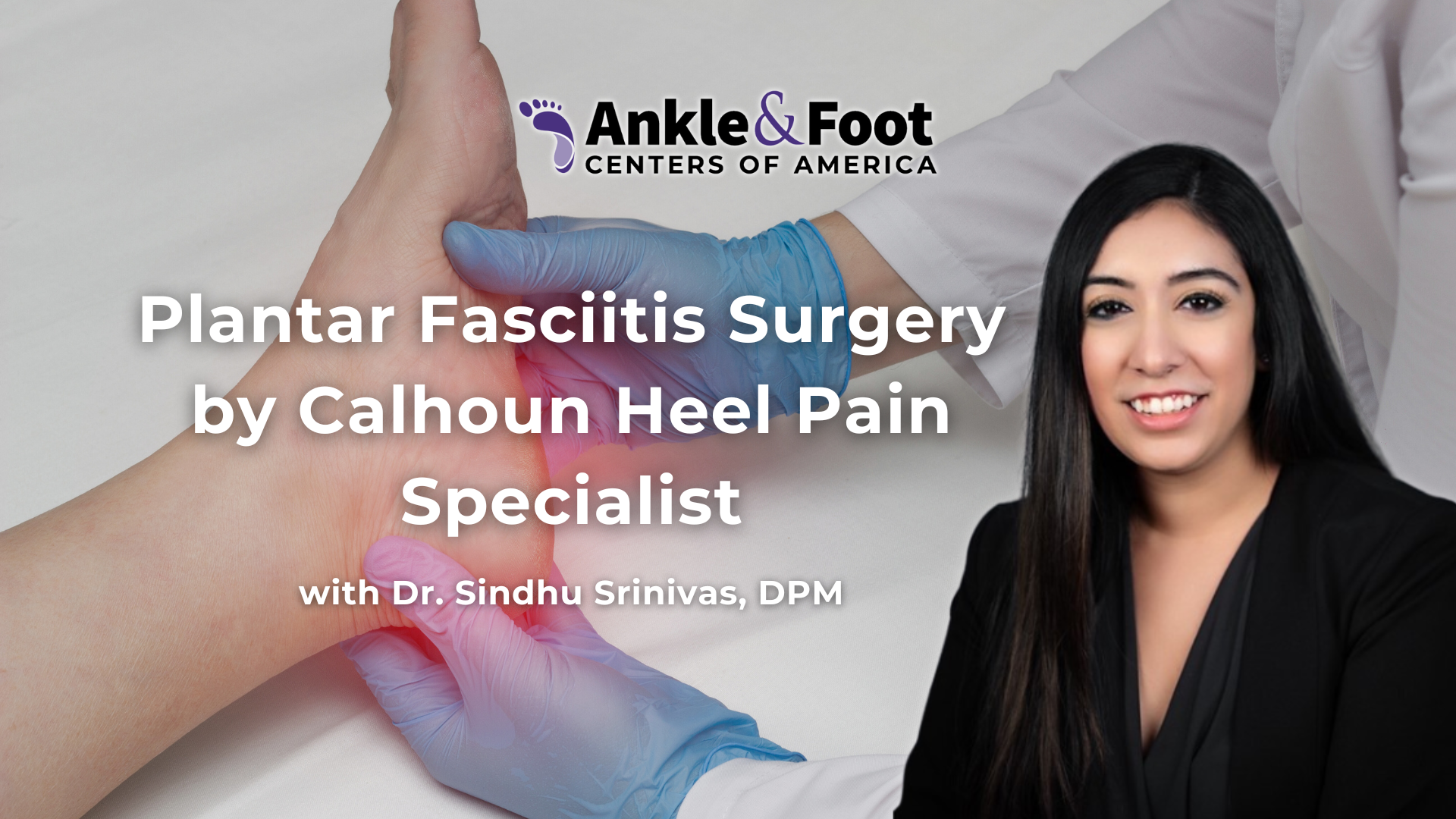Table of Contents
Persistent heel pain keeping you off your feet?
You might be dealing with plantar fasciitis, a common condition that causes stabbing pain in the heel—especially with your first steps in the morning. While many people find relief through conservative treatments like stretching, orthotics, or physical therapy, others continue to struggle with pain that interferes with daily life.
So, is there surgery for plantar fasciitis? In some cases, yes. When non-surgical methods fail to provide lasting relief, surgical intervention may be the next step.
If you’re in Calhoun, a local podiatrist experienced in plantar fasciitis treatment can help determine whether surgery is right for you. With the right care, it’s possible to get back on your feet—pain-free.
What Is Plantar Fasciitis Surgery?
 Plantar fasciitis surgery helps relieve chronic heel pain caused by inflammation or damage to the plantar fascia—a thick band of tissue that runs along the bottom of your foot. When excessive stress overstretches the fascia, it can tear, become irritated, and lead to persistent discomfort.
Plantar fasciitis surgery helps relieve chronic heel pain caused by inflammation or damage to the plantar fascia—a thick band of tissue that runs along the bottom of your foot. When excessive stress overstretches the fascia, it can tear, become irritated, and lead to persistent discomfort.
If conservative plantar fasciitis treatment methods—such as rest, physical therapy, and orthotics—don’t bring relief, your podiatrist may recommend surgery. The procedure works by reducing tension in the fascia, giving the tissue a chance to heal properly.
The most common approach, called plantar fasciitis release surgery, involves cutting a portion of the fascia to relieve pressure and inflammation. In some cases, your surgeon may also address related issues like tight calf muscles or nerve entrapment.
When Is Surgery for Plantar Fasciitis Recommended?
While plantar fasciitis often improves with conservative care, some patients continue to experience pain despite months of non-surgical treatment. If your symptoms persist for 6 to 12 months without relief, your podiatrist may begin to consider surgical options.
Common plantar fasciitis treatments include rest, stretching exercises, orthotics, night splints, physical therapy, and anti-inflammatory medications. These methods work for many, but they don’t always resolve chronic or severe cases.
So, is there surgery for plantar fasciitis when nothing else works? Yes. Surgery for plantar fasciitis is typically recommended only when the pain significantly limits your activity and all other therapies have failed. A podiatrist will evaluate your history, perform diagnostic imaging, and determine if you’re a good candidate for a procedure.
By addressing the root cause of chronic heel pain, surgical treatment can help restore mobility and improve quality of life—especially when done by a specialist experienced in foot and heel conditions.
Types of Surgery for Plantar Fasciitis
 There are a few surgical options available for treating plantar fasciitis when conservative care fails:
There are a few surgical options available for treating plantar fasciitis when conservative care fails:
-
Plantar Fascia Release: The most common procedure. A small portion of the fascia is cut to relieve tension and reduce inflammation.
-
Endoscopic Surgery: A minimally invasive version of plantar fascia release using a small camera and tools.
-
Gastrocnemius Recession: Performed if tight calf muscles are contributing to heel pain. This lengthens the calf muscle to ease strain on the plantar fascia.
Your podiatrist will determine the best approach based on your condition and activity level.
What to Expect During and After Plantar Fasciitis Surgery
Most plantar fasciitis surgeries take place on an outpatient basis, so you can return home the same day. Your podiatrist typically performs the procedure under local anesthesia or sedation, depending on the surgical method. During surgery, they release part of the plantar fascia to ease tension and reduce inflammation.
After the procedure, you’ll need to avoid putting weight on your foot for a short period. Your podiatrist may provide a walking boot or crutches to support your mobility. It’s normal to experience mild swelling, soreness, and bruising during the early stages of healing.
Most patients manage post-surgical pain well, and it usually fades quickly. To ensure a smooth recovery, follow your podiatrist’s instructions carefully—rest, elevate your foot, and attend all follow-up visits.
Plantar Fasciitis Surgery Recovery Timeline
 Recovery from plantar fasciitis surgery varies by procedure and individual healing speed. Here’s a general timeline:
Recovery from plantar fasciitis surgery varies by procedure and individual healing speed. Here’s a general timeline:
-
Week 1–2: Limited weight-bearing with crutches or a walking boot. Keep the foot elevated to reduce swelling.
-
Weeks 3–6: Gradual return to walking with supportive footwear. Light stretching may begin if advised.
-
Weeks 6–12: Continued healing with improved mobility. Physical therapy may be recommended to restore strength.
-
3–6 Months: Most patients return to regular activity. However, full plantar fasciitis surgery recovery time off work may vary depending on your job and the type of surgery performed.
Your podiatrist will guide your recovery and let you know how long the recovery from plantar fasciitis surgery should take in your case.
How Soon Can You Walk After Plantar Fasciitis Surgery?
Many patients start walking with help—such as a walking boot or crutches—within the first couple of weeks after plantar fasciitis surgery. Most people begin walking without support around 2 to 4 weeks, depending on the procedure and individual healing progress.
Doctors often recommend light walking early on to boost circulation and support recovery. Be sure to follow your podiatrist’s instructions, as walking too soon can slow healing or lead to complications.
If you’re asking how soon you can walk after plantar fasciitis surgery, the timeline varies. With the right care, most people regain mobility within a few weeks.
Does Plantar Fasciitis Surgery Work?
Yes, plantar fasciitis surgery can be effective—especially for those who haven’t found relief through non-surgical treatments. Studies show that most patients experience significant pain reduction and improved mobility after surgery.
However, success depends on factors like overall health, the type of procedure, and following post-op instructions. As with any surgery, there are risks, including infection, nerve irritation, or incomplete relief.
That’s why it’s important to work with a skilled podiatrist who specializes in plantar fasciitis treatment. They’ll help determine if surgery is the right step—and ensure the best possible outcome.

Conclusion: Expert Plantar Fasciitis Care in Calhoun
Chronic heel pain from plantar fasciitis can take a toll on your daily life—but lasting relief is possible. If you’ve tried conservative treatments without success, it may be time to explore surgical options. At Ankle & Foot Centers of America in Calhoun, our experienced podiatrists offer both non-surgical and surgical solutions tailored to your needs.
Don’t let foot pain hold you back. Schedule an appointment today and take the first step toward healing with expert care from a team that’s dedicated to keeping you on your feet.






